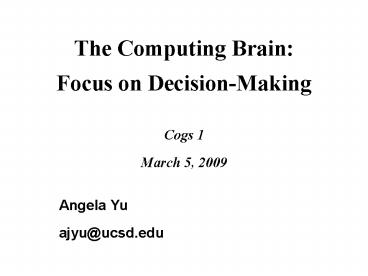The Computing Brain: Focus on Decision-Making - PowerPoint PPT Presentation
1 / 33
Title:
The Computing Brain: Focus on Decision-Making
Description:
Title: Bayesian Decision Theory and Multi-choice Decision-Making Author: Systems Administrator Last modified by: NCC Lab Created Date: 6/9/2005 4:25:58 PM – PowerPoint PPT presentation
Number of Views:216
Avg rating:3.0/5.0
Title: The Computing Brain: Focus on Decision-Making
1
The Computing BrainFocus on Decision-Making
- Cogs 1
- March 5, 2009
Angela Yu ajyu_at_ucsd.edu
2
Understanding the Brain/Mind?
Cognitive Neuroscience
A powerful analogy the computing brain
3
An Example Decision-Making
?
4
An Example Decision-Making
What are the computations involved?
2. Uncertainty
?
1. Decision
3. Costs
5
Monkey Decision-Making
Random dots coherent motion paradigm
6
Random Dot Coherent Motion Paradigm
30 coherence
5 coherence
7
How Do Monkeys Behave?
Accuracy vs. Coherence
ltRTgt vs. Coherence
(Roitman Shadlen, 2002)
8
What Are the Neurons Doing?
Saccade generation system
MT Sustained response
(Britten, Shadlen, Newsome, Movshon, 1993)
(Britten Newsome, 1998)
9
What Are the Neurons Doing?
Saccade generation system
LIP Ramping response
(Roitman Shalden, 2002)
(Shadlen Newsome, 1996)
10
A Computational Description
1. Decision Left or right? Stop now or continue?
?(t) input(1), , input(t) ? left, right, wait
11
Timed Decision-Making
12
A Computational Description
2. Uncertainty Sensory noise (coherence)
13
Timed Decision-Making
14
A Computational Description
3. Costs Accuracy, speed
cost(?) Pr(error) c(mean RT)
Optimal policy ? minimizes the cost
15
Timed Decision-Making
more accurate
- more time
16
Mathematicians Solved the Problem for Us
Wald Wolfowitz (1948)
- Optimal policy
- accumulate evidence over time Pr(left) versus
Pr(right) - stop if total evidence exceeds left or right
boundary
17
Model ? Neurobiology
Saccade generation system
Model
LIP Neural Response
18
Model ? Behavior
Saccade generation system
Model
RT vs. Coherence
boundary
Coherence
19
Putting it All Together
Saccade generation system
- MT neurons signal motion direction and strength
- LIP neurons accumulate information over time
- LIP response reflect behavioral decision (0
coherence) - Monkeys behave optimally (maximize accuracy
speed)
20
Understanding the Brain/Mind?
Cognitive Neuroscience
A powerful analogy the computing brain
21
(No Transcript)
22
Sequential Probability Ratio Test
rt is monotonically related to qt, so we have
(a,b), alt0, bgt0.
In continuous-time, a drift-diffusion process w/
absorbing boundaries.
23
Generalize Loss Function
(Bogacz et al, 2006)
Wald also proved a dual statement
SPRT (with some thresholds) minimizes the
expected sample size lt?gt.
This implies that the SPRT is optimal for all
loss functions that increase with inaccuracy and
(linearly in) delay (proof by contradiction).
24
Neural Implementation
Saccade generation system
25
Caveat Model Fit Imperfect
(Data from Roitman Shadlen, 2002 analysis from
Ditterich, 2007)
Accuracy
Mean RT
26
Fix 1 Variable Drift Rate
(Data from Roitman Shadlen, 2002 analysis from
Ditterich, 2007)
(idea from Ratcliff Rouder, 1998)
27
Fix 2 Increasing Drift Rate
(Data from Roitman Shadlen, 2002 analysis from
Ditterich, 2007)
28
A Principled Approach
Trials aborted w/o response or reward if monkey
breaks fixation
(Data from Roitman Shadlen, 2002) (Analysis
from Ditterich, 2007)
- More urgency over time as risk of aborting
trial increases - Increasing gain equivalent to decreasing
threshold
29
Imposing a Stochastic Deadline
(Frazier Yu, 2007)
Loss function depends on error, delay, and
whether deadline exceed
Optimal Policy is a sequence of monotonically
decaying thresholds
30
Timing Uncertainty
(Frazier Yu, 2007)
Timing uncertainty ? lower thresholds
Theory applies to a large class of deadline
distributions delta, gamma, exponential, normal
31
Some Intuitions for the Proof
(Frazier Yu, 2007)
Continuation Region
Shrinking!
32
Summary
- Review of Bayesian DT optimality depends on
loss function - Decision time complicates things infinite
repeated decisions - Binary hypothesis testing SPRT with fixed
thresholds is optimal - Behavioral neural data suggestive, but
- imperfect fit. Variable/increasing drift
rate both ad hoc - Deadline ( timing uncertainty) ? decaying
thresholds - Current/future work generalize theory, test
with experiments
33
(No Transcript)

